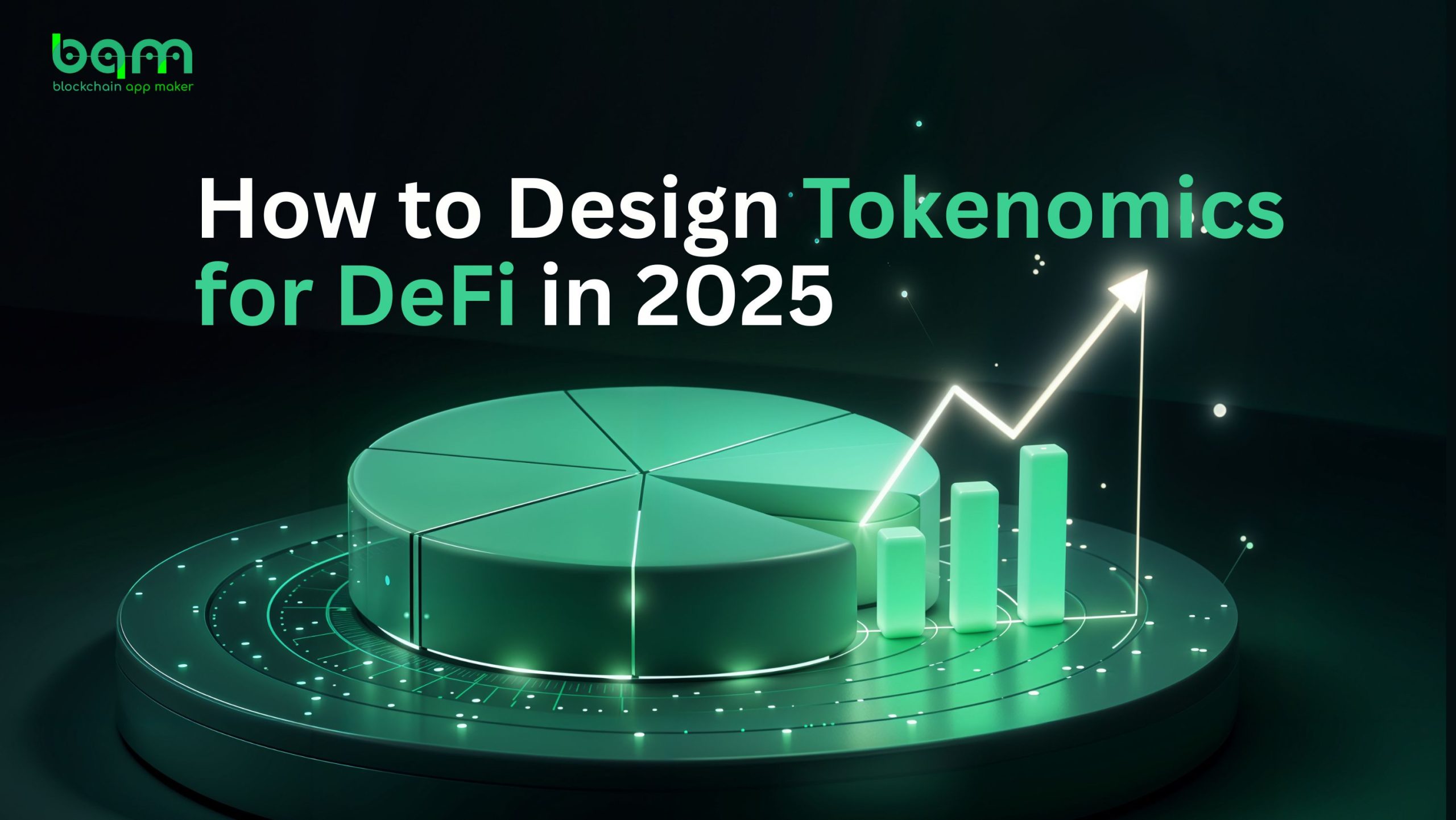The tokenomics of a DeFi protocol have ceased to be the four-step process of determining supply, rewards and a token release schedule. As of today, tokenomics is a direct influence on the liquidity, governance, security, protocol revenue, market trust, and long-term sustainability.
DeFi investors assess tokenomics prior to reading the whitepaper in 2025 – and bad design of models is the biggest success killer of DeFi projects.
This guide provides you with an explicit, practical and professional supported model that enables you to develop sustainable, compliant and optimized tokenomics that are likely to be adopted.
What is Tokenomics in DeFi?
Tokenomics in DeFi refers to the economic design of a crypto token, including its supply, distribution, utility, incentives, emissions, governance, and monetary policy that define how value flows within a decentralized ecosystem.
Why Tokenomics Decide Whether Your DeFi Protocol Succeeds or Fails
Highly successful DeFi protocols such as AAVE, Curve, and MakerDAO are successful due to their token economics that drive a positive feedback loop in which:
- Users want to hold the token
- Liquidity stays deep
- Token value grows with usage
- There is decentralization of governance.
- Rewards are sustainable
Poor tokenomics cause:
- Inflation
- Liquidity collapse
- Dumping pressure
- Governance centralization
- Price volatility
- Protocol abandonment
That is why the creation of tokenomics would be one of the most successful choices in the development of DeFi.
Core Components of a DeFi Tokenomics Model
A good tokenomics system has these parts:
1. How the Token Works:
- Staking it.
- Voting on changes.
- Special access.
- Lower fees.
- Rewards for adding liquidity.
- Using it as collateral.
2. Token Supply:
- Fixed amount.
- More are created over time.
- The amount decreases over time.
- A mix of the above (most common).
3. How Tokens Are Distributed:
- To the team.
- To investors.
- To the community.
- Held in a treasury.
- For liquidity pools.
- As incentives.
4. How It’s Managed:
- How many tokens are released.
- Ways to burn tokens.
- Buying back tokens.
- Changing rewards.
5. How Incentives Work:
- Rewards for providing liquidity.
- Yield farming.
- Staking rewards.
- veTokenomics.
- Sharing fees.
6. Governance:
- DAO.
- Delegation.
- Quadratic voting.
- Locked voting (veTokenomics).
STEP-BY-STEP TOKENOMICS DESIGN FRAMEWORK
This is the most complete, modern, and sustainable design system for DeFi tokenomics.
Step 1 — Define the Purpose of the Token (Utility First)
For a token to work, it needs real-world use.
Ask:
- Why does this system need its own token?
- What actions will require the token?
- How does holding or locking up the token help the user?
Don’t make tokens that are only for governance. Those usually fail fast.
Step 2 — Choose the Token Supply Model
Here are four common supply models:
1. Fixed Supply
- Predictable.
- Scarcity.
- But less flexible.
2. Inflationary Supply
- Encourages people to join.
- But prices can fall fast.
3. Deflationary Supply
- The value goes up.
- But it’s harder to give out rewards.
4. Hybrid Supply (Most Popular)
- Mixes stability with incentives.
- Lets you control how coins are released.
Step 3 — Design Token Distribution Blueprint
A balanced, industry-tested allocation looks like:
| Category | % Allocation | Purpose |
| Community & Rewards | 30–45% | Incentives, liquidity, airdrops |
| Team & Advisors | 10–20% | Long-term alignment |
| Investors | 10–25% | Funding + strategic partners |
| Treasury | 10–20% | Grants, marketing, ops |
| Liquidity Reserves | 5–15% | Exchanges & pools |
Mandatory Best Practices
- Use a vesting schedule (2–4 years).
- Don’t allow tokens to be unlocked right away.
- Keep the team’s token share reasonable.
- Use a lockup period to avoid immediate selling.
Step 4 — Build Token Utility Architecture
Your token can be useful in a few ways:
1. For using the protocol:
- Paying fees
- Getting special features
- As collateral for lending
2. For providing liquidity:
- Staking
- As LP tokens
- For getting better rewards (like Curve)
3. For governance:
- Voting
- Deciding on DAO matters
- Allocating treasury funds
4. For value:
- Sharing revenue
- Token burns
- Buybacks
- veLocking
Step 5 — Build Emission Schedule + Monetary Policy
How an emission model is set up affects its lasting sustainability.
Here are some usual emission models we see:
- Linear Emission
- Halving Emission
- Dynamic Emission (used by today’s protocols)
- Algorithmic Emission (tied to revenue)
Ways to Keep Inflation in Check:
- Token caps
- Emission reduction events
- veLocking
- Buyback-and-burn
- Fee redistributions
Step 6 — Design Incentives for Growth
For any protocol to last, its incentives need to support its long-term health.
Types of Incentives:
- Liquidity Mining
- Yield Farming
- Staking Rewards
- veTokenomics Locking
- Referral Incentives
- Activity Mining
Avoid Too Many Incentives:
A lot of DeFi tokens don’t make it because they inflate too much at the beginning.
Step 7 — Create Governance and Decision-Making Architecture
Governance: Treat it like a tool and plan it well.
Current Governance Types:
- Basic: One token equals one vote.
- Quadratic voting.
- Delegated governance (like AAVE).
- veGovernance (like Curve).
Good Governance Tips:
- Stop big token holders from dominating votes.
- Set a minimum participation level for votes to count.
- Give rewards for taking part in governance.
Cost Breakdown: How Much Does Tokenomics Design Cost?
The cost varies depending on complexity.
| Service | Estimated Cost |
| Basic Tokenomics Model | $3,000 – $5,000 |
| Advanced Tokenomics (DeFi) | $8,000 – $15,000 |
| veTokenomics + Emission Modeling | $15,000 – $25,000 |
| Tokenomics Audit | $3,000 – $7,000 |
| Full Token + Smart Contract Development | $20,000 – $50,000 |
Blockchain App Maker delivers institutional-grade tokenomics models with simulations, audits, and complete technical design.
Pros & Cons of Token Supply Models
| Model | Pros | Cons |
| Fixed Supply | Scarcity, simple | No rewards flexibility |
| Inflationary | Strong incentives | Risk of price dilution |
| Deflationary | Value appreciation | Limited utility incentives |
| Hybrid | Balanced, sustainable | Requires careful modeling |
Inflationary vs Deflationary vs Hybrid — Comparison Table
| Factor | Inflationary | Deflationary | Hybrid |
| Reward Flexibility | High | Low | Medium–High |
| Price Stability | Low | Medium | High |
| Long-Term Sustainability | Medium | Medium | High |
| Most Suitable For | Yield protocols | Scarcity tokens | Modern DeFi dApps |
Real Tokenomics Examples (How Top Protocols Do It)
AAVE
- Governance-based
- Staking incentives
- Safety module
Curve (CRV)
- veTokenomics
- Locking for boosts
- High governance engagement
GMX
- Revenue-sharing token
- Sustainable inflation
- Strong user alignment
Such examples indicate that token design is an evolving process rather than a speculative process as protocols are used.
Future Tokenomics Trends (2025–2030)
Tokenomics is changing fast. Here’s what to expect:
- veTokenomics 2.0 (locks that can change)
- Tokens backed by real income will be normal
- AI/agent systems will handle governance
- Real yield will replace rewards that cause inflation
- Monetary policies driven by algorithms
- Token utilities that can be added easily
- Emission balancing across multiple chains
- Incentive systems that adapt
DeFi tokenomics is changing to focus on being sustainable, not just growing.
TOP 7 FAQS (AEO-Optimized)
1. When starting a DeFi project, what’s the first thing to consider for tokenomics?
Figure out what the token is for and how it will be used. This decision guides supply, incentives, and how it’s handed out.
2. How many tokens should a DeFi protocol have?
Most go with one token for utility and governance. Some use two to keep stability, incentives, and governance separate.
3. How do you stop token inflation in DeFi?
Control token release, veLocking, burn tokens, lower rewards, and reward based on income.
4. What’s a good way to distribute tokens for a DeFi project?
A fair way is to give 30–45% to community incentives, 10–20% to the team, 10–25% to investors, and 10–20% to the treasury.
5. How long should token vesting last?
Most teams use a 2–4 year vesting plan, with no access for the first 6–12 months, to prevent quick sell-offs.
6. What makes a DeFi token valuable?
Staking, governance rights, token burns, lower fees, using as collateral and sharing earnings are big value boosters.
7. When should you get a tokenomics expert involved?
Get them in early, when you’re planning things out—before raising money, coding smart contracts, or launching the token.
Launch Smarter. Scale Faster. Get Expert Tokenomics Built for Real-World Growth
Creating tokenomics is hard, and one slip-up can ruin your protocol.
Blockchain App Maker helps DeFi founders create:
- Token frameworks that last
- Ways to give out tokens
- veToken designs
- Economic models for investors
- Smart contracts + complete ecosystem built
Need a professionally designed DeFi tokenomics model?
Get in touch with our experts and build a token that lasts.


